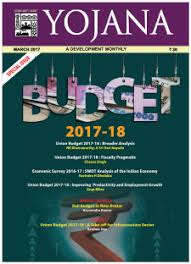(HOT) UPSC Current Affairs 2025 PDF
NEW! The Gist (NOV-2025) | E-BOOKS
(Download) Yojana Magazine Free PDF Archive : March-2017
(Download) Yojana Magazine Free PDF Archive : March-2017
CONTENTS
- Union Budget 2017-18 : Broader Analysis
- N R Bhanumurthy, A Sri Hari Nayudu -7
Do you know? - 12
- Union Budget 2017-18: Fiscally Pragmatic
- Charan Singh - 13
- Revenue Mobilisation Efforts and the Budget 2017-18
- Malini Chakravarty - 20
Special Article
- Rail Budget in New Avatar
- Arunendra Kumar - 25
- Assessing the Changes in Structure and Processes
- Happy Pant - 31
- SWOT Analysis of the Indian Economy
- Ravindra H Dholakia - 35
- HIGHLIGHTS OF THE BUDGET 2017-18. - 41
NORTH EAST DIARY - 46
Focus
- Union Budget 2017-18:
- A Take-off for Infrastructure Sector
- Krishna Dev - 47
- Neo-Developmental Model:
- Marching Towards Greater Glory
- Nirendra Dev - 53
J&K window - 56
- Union Budget 2017-18:
- Big Boost to Agriculture
- Laxmi Joshi, V P Ahuja - 58
- A Budget for the Youth
- S S Mantha - 60
- Improving productivity
- and Employment Growth
- Arup Mitra - 65
- Transforming the Real Estate Sector
- Ranjeet Mehta - 70
- growth in health budget 2017-18
- Rajeev Ahuja - 75
- Weaker Sections: Welfare and Development
- Srikara Naik, Anjali Bansal - 79
Union Budget, this year, was presented amidst a host of uncertainties. Demonetisation drive and imminent GST drive, new administration in US etc. made the whole exercise very challenging. This year’s Budget was also historic as it broke away from age old tradition of being presented on the last day of February, merged the Rail budget with Union budget and departed from the classification of Plan and Non-Plan expenditure.
After the hardships faced equally by the rich and poor post demonetisation, it was being expected that the Budget will come up with some incentives to bring cheer to the public. The Budget however continues to reflect the Government’s priorities of being pro-poor, pro-rural, and pro-farmer and focuses on the long term agenda of boosting economic growth. The overall objective being to “Transform, Energise and Clean” India, the Budget has adopted a multipronged approach and has given attention to all sectors of the economy with adequate thrust on rural development, agriculture, infrastructure, skill development, manufacturing and employment generation.
With farmers and rural population being at the top in the list of priorities, a number of measures have been announced to double the income of the Indian farmers in five years. Agriculture credit allocation has been increased to Rs 10 lakh crore. To save the farmer from the natural calamities, target has been increased to cover 40 per cent of crop area under Pradhan Mantri Fasal Bima Yojana and corpus under Long Term Irrigation Fund has been increased to Rs 40,000 crores.
With the intention of giving big push to rural employment and improve basic amenities in rural areas, several initiatives have been announced for skilling the sizeable youth population. India’s flagship employment generation scheme, MGNREGA has got the highest ever allocation of Rs 48,000 crores. Launch of Swayam with over 300 online courses and allocation of Rs 4,000 crore to train the youth for market-oriented skills under Sankalp are aimed at making India the skill capital of the world. Mission Antyodaya proposes to pull out 1 crore people and 50000 Gram Panchayats out of poverty. Government’s increased focus on rural development is evident from the initiatives such as- setting the target for achieving 100 per cent village electrification by 1st May, 2018, piped water supply on priority basis to Open Defecation Free villages and increasing the pace of the constructions of rural roads- the lifeline of villages, to 133 km per day under Pradhan Mantri Gram Sadak Yojana.
Strong Infrastructure being the basis of any economic development, has got the rightful attention with highest ever allocation of Rs 3.96 lakh crores. Allocation of Rs 1.3 Lakh crores for railways again, is the highest ever allocation for the national carrier with passenger safety; cleanliness and development works being the focus areas. With a view to energise the real estate sector, “Infrastructure” status has been granted to the housing sector.
A number of measures have been taken to encourage investments and increase the Ease of Doing Business. Given that now more than 90 per cent FDI inflow is through direct rout, decision has been taken to abolish the Foreign Investment Promotion Board (FIPB). And to promote the small entrepreneurs, rate of Corporate Income Tax has been reduced to 25 per cent for companies with turnover less than Rs 50 crore.
Allocation of Rs 10,000 crore for Bharat Net, launch of AADHAAR Pay, setting of special task force to address the cyber security concerns reiterate the Government’s commitment to transform the country into a digital economy.
Significantly, in a move to curb black money and cleanse the political system, a maximum limit of Rs 2000 per person has been set for receiving cash donations by political parties. Contributions above this limit can be made only in the form of cheques or digital payments or through electoral bonds.
Taken together, the Budget 2017-18 reiterates the Government’s intentions to bring about greater transparency, reduce corruption and achieve faster economic growth and is a step further in this direction with something for everyone to smile.
Click Here to Download Yojana Magazine March-2017
Courtesy : Yojna Magazine


